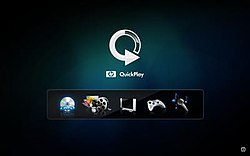An editor has nominated this article for deletion. You are welcome to participate in the deletion discussion , which will decide whether or not to retain it. |
This article has multiple issues. Please help improve it or discuss these issues on the talk page . (Learn how and when to remove these messages)
|
| QuickPlay | |
|---|---|
 HP QuickPlay | |
| Developer(s) | Hewlett-Packard Company / CyberLink Corporation |
| Stable release | 3.7 v.7508 (last release; replaced by HP MediaSmart MVP Software) / discontinued |
| Operating system | Windows, Linux (up to v1.0) |
| Available in | English and other languages |
| Type | Media player |
| License | Proprietary |
| Website | Official HP QuickPlay site |
QuickPlay was a technology pioneered by Hewlett-Packard in 2004 that allows users to directly play multimedia without booting the computer into a main operating system. A media component of HP Pavilion Entertainment laptops, QuickPlay was a feature found in the dv1000 series and above, including the HDX series of notebooks. It is also a feature found in many other HP Compaq notebooks. The technology has also been emulated by other computer manufacturers such as Dell, Alienware, and Toshiba, with various iterations. It is not to be confused with the QuickPlay project hosted by SourceForge.
QuickPlay software, also known as QuickPlay or HP QuickPlay is software custom developed for HP by CyberLink Corp. QuickPlay software revisions up to version 2.3 included in notebooks shipping with Windows XP have two main components. The first component is a "Direct" function that provides instant access upon boot to music CDs, DVD movies, and MP3s stored on the hard drive. It is launched by the QuickPlay external button found on the notebook or included IR remote. QuickPlay "Direct" is possible through software on a separate partition with a custom operating system (Linux for QuickPlay 1.0 and Windows XP Embedded for QuickPlay 2.3) installed. The secondary component of QuickPlay software (all versions) is an application run under Windows with identical functions. Newer versions of the Windows-only component (QuickPlay versions above 2.3) have additional gaming and karaoke functions.
QuickPlay software versions 3.0 and newer included in notebooks shipping with Windows Vista solely retain the Windows-only component as the "Direct" component is no longer implemented due to some unresolved compatibility issues. Instead, users must boot into the operating system in order for the Windows-only version of the QuickPlay software to be run. This occurs regardless of whether QuickPlay is launched externally (via a notebook button or IR remote button) when the notebook is off or when the operating system is running. QuickPlay has since been disconnected, has been replaced by the HP MediaSmart Software on all HP desktops and notebooks shipping with Windows 7 from 2009 onwards.
